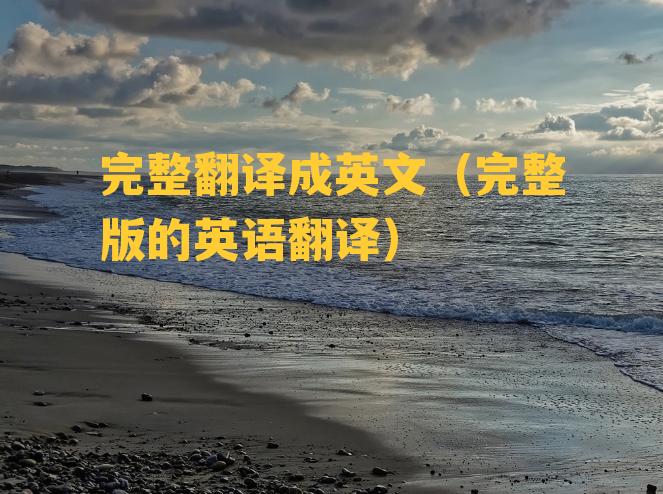完整翻译成英文(完整版的英语翻译)
l. Below is a comprehensive guide on how to approach the task of writing and translating a complete English version of a document.
### Step 1: Understand the Source Material
Before you begin, make sure you thoroughly understand the content of the original document. This includes its context, intended audience, and the nuances of the original language.
#### 1.1. Analyze the Content
- Break down the document into sections or chapters.
- Understand the purpose and structure of each part.
#### 1.2. Research
- If necessary, research the subject matter to ensure accuracy in the translation.
- Note any cultural references that may need clarification or adaptation for the English-speaking audience.
### Step 2: Gather Translation Resources
To ensure a high-quality translation, gather the following resources:
#### 2.1. Dictionaries and Thesauri
- Use English and original language dictionaries to find the most accurate translations.
#### 2.2. Glossaries
- Create or find glossaries specific to your document's field or industry.
#### 2.3. Translation Software
- Utilize translation software as a tool, but not a replacement for a professional translator.
### Step 3: Write the English Version
Once you have a solid understanding of the source material and the necessary resources, start writing the English version.
#### 3.1. Transcribe the Content
- Transcribe the content from the original language into English.
ns the original meaning and intent.
#### 3.2. Structure and Formatting
- Adhere to the standard English formatting and structure.
- Use headings, subheadings, and bullet points where appropriate.
#### 3.3. Tone and Style
- Match the tone and style of the original document.
- Adjust the language to suit the intended English-speaking audience.
### Step 4: Proofread and Edit
After writing the first draft, thoroughly proofread and edit the document.
#### 4.1. Proofreading
- Check for grammatical errors, typos, and inconsistencies.
- Ensure that the translation flows smoothly and reads naturally.
#### 4.2. Editing
- Look for areas where the translation might be unclear or could be improved.
- Consider the overall coherence and impact of the document.
### Step 5: Seek Feedback
Get feedback from peers or experts in the field to ensure the quality of your work.
#### 5.1. Beta Readers
- Have beta readers review the document for content and clarity.
#### 5.2. Subject Matter Experts
- Consult with experts to verify the accuracy of technical or specialized content.
### Step 6: Finalize the Translation
After incorporating feedback and making necessary revisions, finalize the translation.

#### 6.1. Final Proofread
- Conduct a final proofread to catch any lingering errors.
#### 6.2. Formatting Check
- Ensure that the document's formatting is consistent and meets any required standards.
### Step 7: Publish or Distribute
Once the translation is complete and has been thoroughly checked, publish or distribute it according to your original plan.
By following these steps, you can effectively write and translate a full-length English version of a document, ensuring that it is accurate, coherent, and engaging for your target audience.











